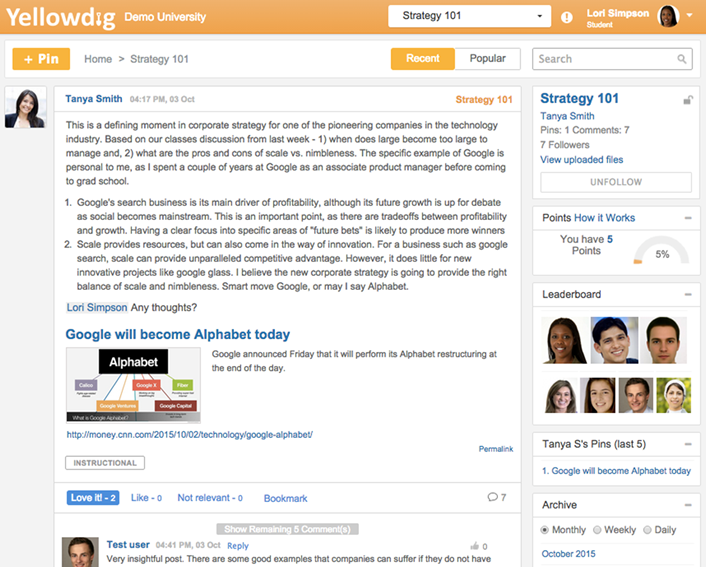"Alright everyone, we'll pick up the discussion here next week."
That's a parting comment familiar to every professor and student. And while bookmarking a course is useful, it's also static, even limiting. Sure, the instructor issues assignments, but aside from group projects, class activities usually happen in isolation even though we know a collaborative environment expands and enriches education.
What can we do? A current convergence of technology trends can help facilitate out-of-the-classroom engagement and collaboration, but also capitalize on technological infrastructures and behaviors already deeply ingrained in today's students. This starts by recognizing that technology is a core and permanent part of student life — socially, organizationally, communicatively, and academically. By embracing appropriate technology in the classroom, we can realize its potential for supporting more engaging and effective pedagogy.
Going back to the hypothetical class that's breaking until next week, I see countless opportunities to enhance the educational experience between lectures. What's required is the right technology: designed for students; mirroring their use habits, patterns, and preferences; and resembling the applications they already know and love. (Think Facebook, Instagram, Twitter, Pinterest, or Snapchat.)
Not unexpectedly, a handful of startups are already pursuing those opportunities for collaborative and immersive learning. I had the opportunity to experiment with one new product, Yellowdig, in conjunction with my Strategy class. As the instructor, I am charged with helping students understand what strategy is and how it is successfully and unsuccessfully implemented in multiple industry settings. Given the breadth of the topic and the pace at which industries are evolving, I believe that this course should not rely on a single fount of knowledge. Instead, it should be a collaborative responsibility shared among all participants, primarily the students — the co-curation of content, if you will. Picture one student sharing a strategic success story from within their firm and another sharing an article on recent trends in entrepreneurship. Then envision an alumna sharing her firm's current vision and strategy statements with students in my course. Ultimately, this results in a vibrant community in which students exchange knowledge, participate in deep conversations, and continuously engage with the material.

From a technical perspective, Yellowdig integrates with most learning management systems. It allows students to share relevant links, photos or notes with their classmates as a feed, and classmates can up-vote and discuss posts. Users can build their “influence” score by getting up-votes, posting on the platform and gaining followers. Professors can monitor progress through the Yellowdig dashboard and the recently launched points system.
Does this approach move the whole experience online? Not at all. In creating a digital space for this knowledge exchange, participation, and engagement, the in-classroom experience takes on a life of its own, separate from the traditional lecture and related class discussion. When my class picks up again the next week, we have a week's worth of ideas and perspectives to guide the conversation and introduce new elements to the discussion. As an instructor tapped into that activity (instructors are the administrators for their Yellowdig), I know the elements of the material about which the students are most enthused and have new perspectives to weave in. I have new, co-curated resources and can modify what I, as the instructor, bring to the table.
Learning isn't passive — and that's exactly the potential I'm excited about here. Technology that can blend the offline and online experiences in ways that feel natural and familiar to students will drive the active exploration of knowledge. When this community is created and encouraged, learning becomes perpetual — the results of which will differ drastically from a course where the motivation is simply a grade. It was amazing to see how little motivation students needed to start engaging in extremely insightful discussions. Repeatedly, the message I receive from students is, "I wasn’t sure at first, but once I jumped in I completely got it."
Jeremy Petranka is an associate professor of the Practice at The Fuqua School of Business at Duke University. His teaching and research areas of focus include managerial economics, competitive analysis, game theory, industrial organization, culture, and IT strategy.
© 2015 Jeremy Petranka. This EDUCAUSE Review blog is licensed under Creative Commons BY-NC-ND 4.0 International.
